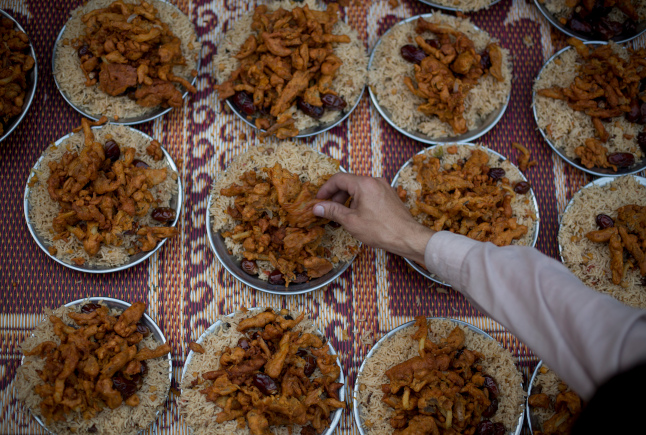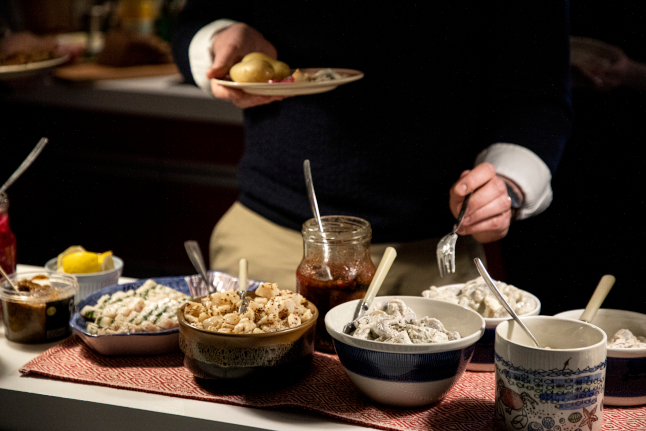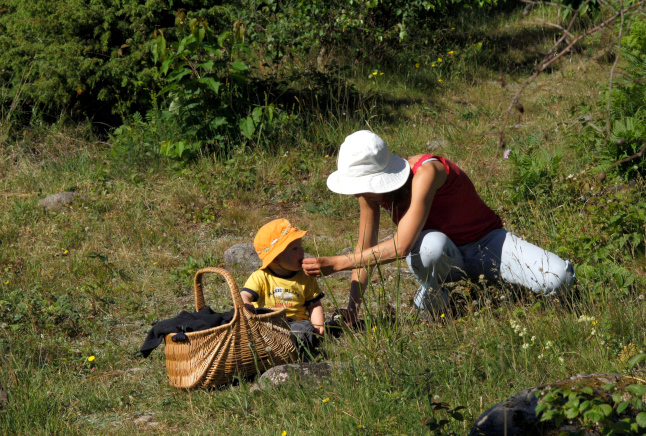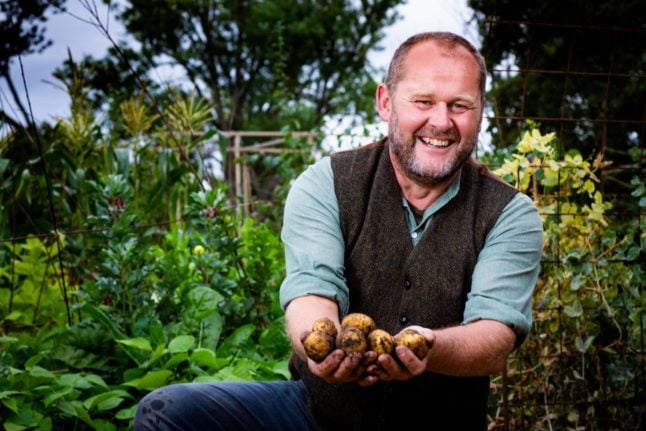Born and raised in a country where food sits smack in the centre of all life activities, it's hard to adjust to a palate too different. Pakistan and Sweden, the two countries I fondly call home, are only so close on the dining table as on the map but despite the cross-cultural nuances, food is the incredibly powerful force that firmly holds this diverse planet in place, bringing out the beauty of differences.
I grew up in the beautiful city of Lahore, famous for its love for food. Busy roads are abundantly dotted with street food flowing with a range of incredible crispy, crunchy, spicy, juicy flavours. From weddings to funerals, most events are extravagantly laced with one form of food or the other.
One can expect food at celebratory gatherings such as ceremonies, concerts, festivals and house parties, to more solemn events like religious sermons and memorial services. Sometimes, the same dish when served in a different platter can change the tone of the event.
While nothing is considered sexier than a man who can cook, a typical Pakistani kitchen is lovingly managed by the women of the house, while men take pride in keeping it stocked.

Photo: AP Photo/B.K. Bangash
Food naturally takes centre stage in the primarily agricultural economy of Pakistan. Traditionally, lunch is served with white rice or flatbread such as naan or roti. A humble naan can undergo a miraculous transformation into a royal Kulcha, by adding a layer of clarified butter (ghee) topped with a pinch of roasted sesame seeds. The gravy is usually some kind of meat cooked in rich tomato-based curry.
Daal chaaval (lentils served with boiled rice) is a staple. Like the Italian pizza, the mighty daal was once the food of the poor, which has over time stolen the spotlight as a national favourite. Summer lunches are usually adorned by a generous serving of achaar; sleek chunks of unripe mangoes, meticulously pickled in aromatic mustard oil. The deal is usually sealed with a side serving of fresh vegetable salad and a dash of mint and coriander raita.
No meal goes down without the traditional yogurt-based drink lovingly called namkeen or kachi lassi, which comes in dozens of creative variations. An Indian version is Bhang Lassi, which is cannabis flavoured and is frequently used as a prank. Chai is the magical drink that all Pakistanis, rich and poor alike, wake up to. It's a sentiment, more than a drink, served hot with milk, sugar and a swift swirl of love!
As George Bernard Shaw famously said and I agree: “There is no love sincerer than the love of food.”

A generous offering of pickled herring at a Swedish Christmas buffet. Photo: Christine Olsson/TT
In Sweden, the concept of food is rather simple, tracing back to the Viking times. The harsh Scandinavian winters didn't do any favours when it came to raising animals, limiting food choices to mostly pickled meat and vegetables. Swedes have adapted to a predominantly simple diet but when they feast, they feast like there's no tomorrow!
Outdoor grilling starts with the very first signs of spring and almost everything is grilled, but the short Swedish summers limit this country's epic barbecue love affair to a seasonal fling. Swedes love their Salmon, both cured and smoked but thanks to the abundance of herring in the Baltic sea, it almost effortlessly takes centre stage on the Christmas table. The Swedish smörgåsbord represents the Swedish way of life: vibrant, nutritious and generous. There's always something for everyone.
In Sweden, almost anything edible can be squeezed from a tube; be it caviar, flavoured cheese, liver pate, tomato pure, anchovies cream, grated horseradish, you name it.
The typical Swedish smörgås is a single sliced sandwich that can be topped with anything under the sun. Legend traces the trend back to the 1400s when bread was used as a plate.
Be it the iconic Swedish meatballs or age old staples like pancakes and porridge, lingon jam (lingonsylt) goes with everything. Soups are always a win-win, served hot or cold. Traditionally, Pea soup (ärtsoppa) and pancakes are served on Thursdays, a trend tracing back to the Second World War.
Fridays are all about family time. Cosy Friday or fredagsmys kick starts a weekend that's spent curled up on a couch surrounded by food, pets and freedom. A rather wise, unwritten rule limits the consumption of candy to once a week, often Saturdays; hence the mind-blowing Swedish smile showing perfect pearly whites.

A mother picking wild strawberries with her child in Sweden. Photo: Hasse Holmberg/TT
One can't talk about food in Sweden without mentioning the popular and fairly abundant, incredibly juicy wild strawberries or smultron, which are best eaten with a dollop of whipped cream, or can be used to make tarts, jams, pies or juice. The moment July kicks in, Swedes prepare to get back to basics in their insanely picturesque summer cottages called sommarstuga, picking berries all the way to August.
While berry-picking in Sweden has been a tradition for ages, legend has it that the love for mushroom-picking gained momentum after France's Jean-Baptiste Jules Bernadotte (King Karl XIV Johan) came to Sweden in 1810. While the Swedish karljohansvamp (Karl Johan mushroom) is plentiful enough to be exported to France and Italy, the golden chanterelle remains the real king of mushrooms in Sweden. Fried in a knob of butter, it rocks as a side dish.
Swedish summer stumbles towards a reluctant end focusing the spotlight on crayfish, the heavenly delicious red, bite-sized freshwater shellfish. This national delicacy unites the nation in a frenzy of celebration on almost every balcony and garden.
Finally, autumn rolls in with a damp, almost tangible smell of mushrooms in the air. Snug scarves and woollies begin to replace summer hats, and sandals give way to boots. Allemansrätten or the 'Right of Public Access' in the Swedish law stipulates that everyone is free to pick flowers, berries and mushrooms in the Swedish countryside, without the fear of trespassing. It warms the heart to see cheerful groups of people carrying their telltale weaved cane baskets on their bicycles giggling their way to forests loaded with nature's abundance.
In Pakistan when it comes to food, the how is more important than the what. Meals are eaten together amid small talk, big talk, gossip, jokes, arguments and more often than not, a side dish of harmless family drama. The quality of the dinner table theatrics depends on the current position of the earth around the sun; the warmer the weather, the louder the arguments. That's how we bond in my homeland.
Swedish eating style, on the other hand, is an almost therapeutic ritual; focused, polite and predominantly silent. Swedes find it intrusive to push their guests to taste all that's been served while Pakistanis take it to their heart if the guest doesn't reach for seconds. Pakistani mothers fondly spoon feed their children (sometimes as old as 50 years!) as a symbol of affection, while Swedes consider it borderline offensive to force any form of food in a child's mouth.
Swedes usually declare the meal open, with the host muttering a polite “varsågoda” under their breath while Pakistanis prefer to dig in with an exaggeratedly hearty “Awo jee Awo, Bismillah kero!”
Swedish end-of-meal-rituals are straight-forward. Everyone, young or old, guest or host, is expected to pick up their plate and place it in the kitchen, or even better, in the dishwasher itself. Pakistanis, on the other hand, consider it offensive if the guest offers to help clear the table.
While coffee is steadily gaining popularity in Pakistan, and tea in Sweden, the timeless battle between the two drinks is equally ferocious in both the countries.
Food unites our differences. Sitting on a frozen lake in Lammhult, fishing through a hole, I feel the same warmth of butterflies in my tummy, that I feel while plucking unripe guavas in the long summer afternoons in my garden in Lahore. I hear the swishing of dry corn roasting in a mix of sand and salt on the streets of my hometown, with the same intensity as the squawking seagulls stealing roasted anchovies straight from my hand by a seashore in Sweden.
Be it the meat of a freshly hunted moose (älgskav) in a remote Swedish village or a goat slaughtered on the festive days of Eid-ul-Azha; the savoury flavors jolt my taste buds in the same, surprisingly familiar way. Food interacts with my senses before it interacts with my body. It touches my soul, before it touches my tongue.

People with cattle on Eid-ul-Azha in Pakistan. Photo: AP Photo/B.K.Bangash
Food to me is a celebration of life, of diversity and of differences. It's a global connector, a weapon of mass construction of sorts.
It is therefore no less than an insult to human intelligence that on such a magical, bountiful planet, one in nine people go to bed on an empty stomach at night while one third of all food produced for human consumption is wasted. Even though the world today is overwhelmed by the corona pandemic, the UN Sustainable Development Goals stand urgent as ever. Goal 2- Zero hunger, that pledges to end world hunger by 2030 has never in history been a more pressing global need.
I'm a dreamer. I colour this disappointment with hope. In my head, exists a world where food is that profoundly spiritual universal key that celebrates our fascinating cultural diversity and unlocks the limitless bounties of this generous and forgiving planet.
I dream of a world where countries unite in their differences and food becomes border-blind. A world where the vibrant robustness of Pakistani food meets the sustainable attitude of Sweden to create the ultimate amalgam of a world where no one sleeps hungry again.
This piece was originally published on Medium and republished with the author's permission. Mehkar Sheikh is a career educationist, restless travel enthusiast, fitness junkie, and a proud tree-hugger, currently based in Stockholm. Follow her on Instagram and Medium.




 Please whitelist us to continue reading.
Please whitelist us to continue reading.
Member comments